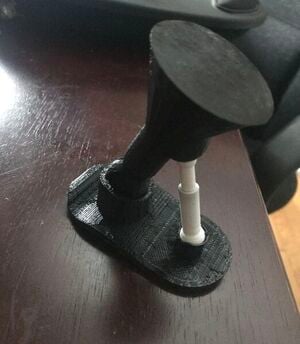
An open sourced appropriate technology OSAT can be used to help people in need. This 3D printable prosthetic foot design was built to help reach out to those in need of a foot. Prosthetics have been around for a long time and are in the simplest form just sticks or the next level carved wood. Think of pirate's who had hooks or stick legs. Today there are a range of devices on the market to help aid those in need, even some that are very similar to the robotic hands that Luke and Darth Vader have in Star Wars. Some more examples and sources can be found here Prosthetics Through The Ages
This design hopefully steps farther than a wood foot would, yet is simple enough technology that anyone can use it if they have access to a 3d printer and these files. The design is still in it's infancy, but with the help of other open source developers and more knowledge from the community it could go far.

Bill of Materials[edit | edit source]
- Functional 3D printer
- 3D printer filament computable with printer (I used PLA for my prototype, other materials may be nicer on skin)
-May want some sort of clothe between skin and plastic -May also need to have or carve out a holster for a good fit to the user. This design just has a flat end at the moment.
Click Here for CAD and STL files
Tools needed[edit | edit source]
- MOST Delta RepRap or similar RepRap 3-D printer
- Filament
Skills and knowledge needed[edit | edit source]
- Knowledge of the anatomy of walking [1]
- FreeCAD Designing
Technical Specifications and Assembly Instructions[edit | edit source]
- Scale the foot to desired size. This may be done in the slicing software. *Be sure to scale all parts equally*
- You may print all pieces at once if they fit on your print bed. But I recommend printing the leg piece separately because it is taller than the other pieces. (A 80mm long foot takes about 2 hours to print at 20% fill and 3 hours at 100% fill)
- After printing, insure the inside of the damper and joints of the foot are clean of filament "strings"
- Place the small damper into the larger damper
- Insert the ankle joint of the leg piece into the ankle joint of the foot piece. They should snap into place with a little force.
- Insert the ball joints of the damper into the foot and leg. The larger end goes to the foot.
- Secure a device that will be contacting the skin to the flat surface of the leg end. This could be clothe or another prosthetic end. (This has room for improvement in the design)
- Include print time estimate
- Include assembly time estimate
- Including drawings or pictures of the device at stage of assembly at minimum. (Upload)
- Consider video if appropriate
Common Problems and Solutions[edit | edit source]
- Print the foot on it's side with supports
- The snap pieces must be the same scale (if they are wrong the pieces will either be too large and not fit, or too small and not stay in place). Adjust the scale to form a fit. If that still fails the source files need to be adjusted so that more than 50% is inside the socket and is just smaller than a perfect fit.
Cost savings[edit | edit source]
For a 18cm long foot at $20 per 1kg PLA:
- 100% infill is ~$15.50
- 20% infill is ~$6.50
- Commercial solutions could be upwards of $400
- This printed solution is 4% the price, but needs some work to be equivalent in quality.
Benefited Internet Communities[edit | edit source]
References[edit | edit source]
.